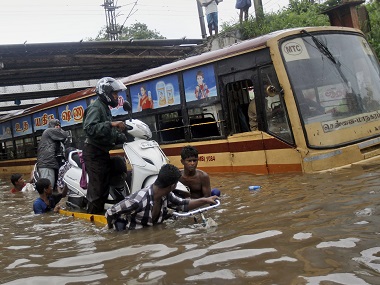By Dinesh C Sharma The devastating rains and floods in Chennai and other parts of Tamil Nadu have coincided with climate talks in Paris where world leaders have gathered to discuss how to save the planet from adverse impacts of climate change. Extreme weather events, such as the one we are seeing in Chennai, are one of the most visible impacts of changing climatic conditions. It is imperative that we take stock of the changing climate with a view to mitigate the effects of extreme weather conditions on human lives, and infrastructure. While the Doha round of climate negotiations was in progress in December 2012, the Philippines was hit by powerful typhoon, Bopha. Its repercussions were felt in Doha as well. Naderev Sano, lead negotiator of the Philippines, while addressing plenary session of the climate conference broke down while addressing delegates. Sano was in tears while describing the destruction of life and property caused by the typhoon. This was a dramatic moment of climate talks, which brought hard-nosed negotiators face to face with climate realities. [caption id=“attachment_2507814” align=“alignleft” width=“380”]  The ongoing floods in Chennai. AP[/caption] Chennai floods have figured in discussions on the sidelines in Paris but it has not become dramatic event like the one involving the diplomat from the Philippines. Adaptation to climate change is one of the main themes of the climate talks. It simply means that if global mean temperature is going to rise, as predicted under different models and scenarios, countries will have to adapt to this change. They have to learn to live with impacts of climate change. Compensation for loss and damage due to climate change related disasters is part of the agenda in climate talks. Extreme rainfall in Chennai and resulting floods come as part of a series of weather events unfolding in most ecologically vulnerable parts of India – coastal regions and hilly areas. Two most destructive extreme weather events have been seen in the Himalayan region – Uttarakhand disaster of June 2013 and September 2014 floods in Kashmir. In the coastal region, we have had Mumbai floods of 2005 and now floods in another major coastal city, Chennai. In between, there were several weather events in the coastal and inland regions such as cyclone Hudhud which battered Visakhatpatnam and other towns in Andhra Pradesh and severe hailstorms that flattened crops worth several hundred crores in large parts of western and central India in the past two years. All these have led to great economic loss to people, besides exposing complete unpreparedness to meet the challenge of changing climatic patterns. “The changing climate is posing unprecedented challenges to existing human and economic activities, natural ecosystems, and man-made ecosystems in many ways. It is creating new risks for their existence as well as safe and economically viable operations,” points out a study of climate adaptation in India released this week. “Projected increase in extreme precipitation events may cause enormous damage to infrastructure and also result in flooding, which in turn may affect crop production and other socioeconomic aspects in India,” warned the study jointly done by IIT Gandhinagar and IIM Ahmedabad. India has experienced substantial changes in mean and extreme climate during the period of 1951- 2013, according to the analysis based on IMD data. For instance, mean annual air temperature has increased in many regions of the country. Other than the mean annual air temperature, prominent increase was observed in the number of hot days, night-time temperature, and growing degree days during the period of 1951-2013. The monsoon season rainfall became more erratic leading to some of the most severe and widespread droughts during the recent decades (2002, 2009 and 2015). The increased frequency of droughts poses challenges to food security and water management. Climate adaptation would mean re-looking and upgrading urban infrastructure and economic activities in vulnerable regions from climate risk point of view. Key facilities like government buildings and health infrastructure have to be retrofitted to so that they remain functional in the event of a disaster like floods. For instance, all major government hospitals in Srinagar were flooded and did not remain functional when they were needed the most. In most hospitals several facilities like blood bank, path labs, x-ray rooms, outpatient rooms were in either basement or ground flood which were the first to get flooded. No lessons were learnt from this experience in Kashmir because in Chennai too several hospitals and their key facilities have been flooded. If the state had a functional disaster management plan, health facilities should have been secured, along with other essential facilities. Being a coastal city and prone to water logging and flooding, health facilities in Chennai should have been prepared for such a disaster. Visakhapatnam experience showed that even newly constructed airport could not withstand high speed winds and heavy rainfall. This should have alerted airport authorities and airport companies in coastal cities to do disaster-safety review. Then there are important installations, including nuclear power stations, research centres and defence units, along the coast. All these will have to be made climate-secure. The cost of taking all such adaptation measures will be huge. That’s why India and other developing countries are asking for additional finds and technology in the climate negotiations.
It is imperative that we take stock of the changing climate through a lens of disaster and climate risk management and take adequate measures to adapt urban infrastructure
Advertisement
End of Article
Written by FP Archives
see more


)

)
)
)
)
)
)
)
)



